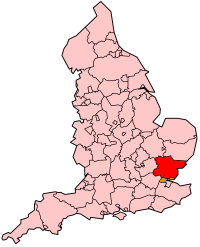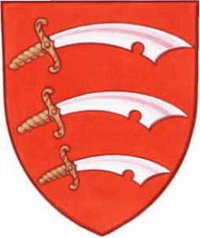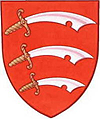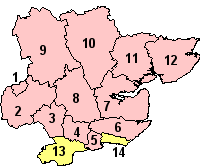Essex

Essex's Location within England |

Essex's Coat of Arms |
- Harlow
- Epping Forest
- Brentwood
- Basildon
- Castle Point
- Rochford
- Maldon
- Chelmsford
- Uttlesford
- Braintree
- Colchester
- Tendring
- Thurrock
(Unitary)
- Southend-on-Sea
(Unitary)
|
Essex
is a county in the East of England. It borders Greater
London to the south west, Hertfordshire
by the River Stort to the west, Cambridgeshire
and Suffolk by the River Stour to the north and
Kent by the River Thames to the south.
The county town is
Chelmsford and the highest point
of the county is Chrishall Common near the village of Langley
near the Hertfordshire border, which reaches 147m/482ft.
| Geography |
| Status |
Ceremonial &
(smaller) Non-metropolitan county |
| Region |
East of England
|
Area
- Total
- Admin Council
- Admin Area |
Ranked 11th
3,670 km²
Ranked 11th
3,465 km² |
| Admin HQ |
Chelmsford |
| ISO 3166-2 |
GB-ESS |
| ONS code |
22 |
| NUTS 3 |
UKH33 |
| Demographics |
Population
- Total (2002 est.)
- Density
- Admin Council
- Admin Pop.
|
Ranked 6th
1,629,647
443 / km²
Ranked 2nd
1,324,092 |
| Ethnicity |
96.8% White
1.2% S. Asian |
| Politics
|
| Executive |
Conservative |
| Members of Parliament |
David Amess
John Baron
Simon Burns
Douglas Carswell
James Duddridge
Mark Francois
Alan Haselhurst
Bernard Jenkin
Eleanor Laing
Andrew Mackinlay
Brooks Newmark
Eric Pickles
Bill Rammell
Bob Russell
Angela Smith
Bob Spink
John Whittingdale |
History
Essex
is a county in the East of England which originated as the ancient Kingdom
of Essex and one of the seven kingdoms, or heptarchy, that went on to
form the Kingdom of England.
Origins
The name Essex derives
from the Kingdom of Essex or Kingdom of the East Seaxe which was founded
around 500 AD, occupying territory to the north of the River Thames and
east of the River Lee.
In 825 AD it became
part of the Kingdom of Wessex and was later ceded under the Treaty of
Wedmore to the Danelaw control of the Kingdom of East Anglia. In 991 AD
the Battle of Maldon resulted in complete defeat for the Anglo-Saxons
against the Vikings and led to the poem The Battle of Maldon.
Hundreds
The county was divided into
the hundreds of:
- Barnstable Hundred
- Becontree Hundred
- Chafford Hundred
- Chelmsford Hundred
- Clavering Hundred
- Dengie Hundred
- Dunmow Hundred
- Freshwell Hundred
- Harlow Hundred
- Harwich Hundred
- Royal Liberty
of Havering
- Hinkford Hundred
- Lexden Hundred
- Ongar Hundred
- Rochford Hundred
- Tendring Hundred
- Thurstable Hundred
- Uttlesford Hundred
- Waltham Hundred
- Winstree Hundred
- Witham Hundred
Victorian era
Much of the development
of the county was caused by the railway. By 1843 the Eastern Counties
Railway had connected Bishopsgate station with Brentwood
and Colchester and by 1884 the London,
Tilbury and Southend Railway had connected Fenchurch Street railway station
in the City of London to Grays,
Tilbury, Southend-on-Sea
and Shoeburyness. The railways
were built primarily to transport goods but unintentially created the
holiday resorts of Southend, Clacton
and Frinton-on-Sea.
County councils were
created in England in 1888.
Essex County Council became based in Chelmsford.
Its control did not cover the entire county. The suburbs of East Ham and
West Ham were created as county boroughs independent of county council
control.
Post war
Much of Essex
is protected from development near to its boundary with Greater
London because of the greenbelt laws created after the war. In 1949
the new towns of Harlow and Basildon
were created. These developments were intended to address the cronic housing
shortage in London but were not intended
to become dormitory towns, rather it was hoped the towns would form an
economy independent of the capital. Furthermore the railway station at
Basildon, with a direct connection
to the City, was not opened until 1974 after pressure from residents.
The proximity of London and its economic
magnetism has caused many places in Essex to become
desirable places for workers in the City
of London to live.
As London
grew in the east places such as Barking
and Romford were given greater autonomy
from Essex and created as municipal boroughs. In
1965 the London Borough of Newham, London Borough of Waltham Forest, London
Borough of Barking and Dagenham, London Borough of Redbridge and the London
Borough of Havering were created and transfered from Essex
to Greater London.
Recent history
In 1998 the boroughs
of Thurrock and Southend-on-Sea were given unitary authority status and
ceased to be under county council control. They remain part of the ceremonial
county.
Population and Settlement
Because of its proximity
to London and the economic magnetism
which that city exerts, many of Essex's settlements function as dormitory
towns or villages where London workers
raise their families. Essex is known for being the
origin of the political term Essex man, and of the Essex girl joke. Essex
has recently overtaken Lancashire as England's
most populous county.
The pattern of settlement
in the county is diverse. The London Green Belt has effectively prevented
of the further sprawl of the metropolis into the County, although it contains
the new towns of Basildon and Harlow,
originally developed to resettle Londoners following the destruction of
London housing in World War II but since much expanded. Part of the south
east of the county, already containing the major population centres of
Southend and Thurrock,
is within the Thames Gateway and designated for further development. To
the north of the Green Belt, with the exception of major towns such as
Chelmsford, the county is rural,
with many small towns, villages and hamlets largely built in the traditional
materials of timber and brick, with clay tile or thatched roofs. Colchester
in the north east of the county is Britain's oldest recorded town, dating
back to Roman times, and has a rich history. A book has been recently
published called '350 miles: An Essex Journey' by photographer Jason Orton
and writer Ken Worpole, detailing a journey by foot and bicycle along
the full length of the distinctive Essex coastline (ExDRA 2005).
In 1998 the districts
of Southend-on-Sea (pop. 160,300)
and Thurrock (pop. 143,000) separated
from the county of Essex becoming unitary authority
areas.
Transport, Commerce and Industry
The Lakeside Shopping
Centre at Thurrock was one of England's
first out-of-town shopping centres; it remains popular despite congestion
on the nearby M25 motorway and direct competition from Bluewater Shopping
Centre.
Essex
also contains Stansted Airport and several smaller aerodromes that have
evolved from bomber or fighter bases constructed during World War II.
The port of Tilbury
is one of Britain's three major ports, while the port of Harwich
links the county to the Hook of Holland. Despite the road crossing to
Dartford in Kent
across the River Thames, a pedestrian ferry to Gravesend,
Kent still operates from Tilbury
during limited hours.
Industry is largely
limited to the south of the county, with the majority of the land elsewhere
being given over to agriculture. Harlow
is a centre for electronics, science and pharmaceutical companies, while
Basildon is home to the Ford Motor
Company and many related businesses. Chelmsford
has been an important location for electronics companies since the industry
was born, and is also the location for a number of insurance and financial
services organisations, and is the home of the soft drinks producer Britvic.
Other businesses in the county are dominated by light engineering and
the service sector.
Places of Interest
- Abberton Reservoir
- Colchester Castle,
Colne Valley Railway
- East Anglian Railway
Museum
- Hedingham Castle
- Mangapps Railway
Museum (Burnham-on-Crouch), Mistley towers
- St Peter-on-the-Wall
- University of
Essex (Wivenhoe Park, Colchester)
- Waltham Abbey
- Harlow New Town
|






